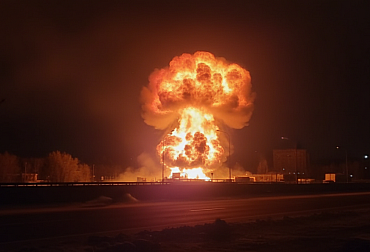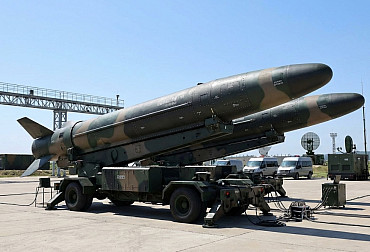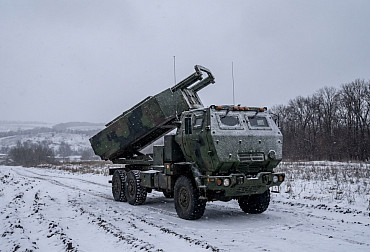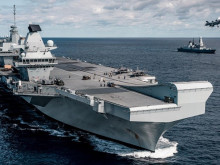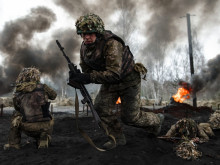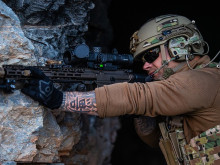The Czech Army is building a system for information superiority
The ongoing war in Ukraine has brought a huge interest in unmanned aerial vehicles, which have proven to be extremely effective tools there. The media usually focuses on drone strikes, but these actions, while often remarkable, represent only a small part of the true significance of unmanned machines. Indeed, the greatest real contribution of this technology (and one of the main causes of the gap between the military effectiveness of the two sides) is its application in reconnaissance and surveillance, as it also brings about a fundamental change in the whole process of military command and control. In addition to drones, other categories of technology are of course also being used in this role, notably space satellites and, in addition to these, for example, observation balloons, which have also attracted a great deal of interest in recent weeks. It is all the more important to stress that powerful drones, balloons and satellites will prospectively enrich the arsenal of the Czech Army, which wants to create its own sensor system for Earth observation. The main partner in this project is Israel, which will supply the Czech army with Heron 1 unmanned aerial vehicles.
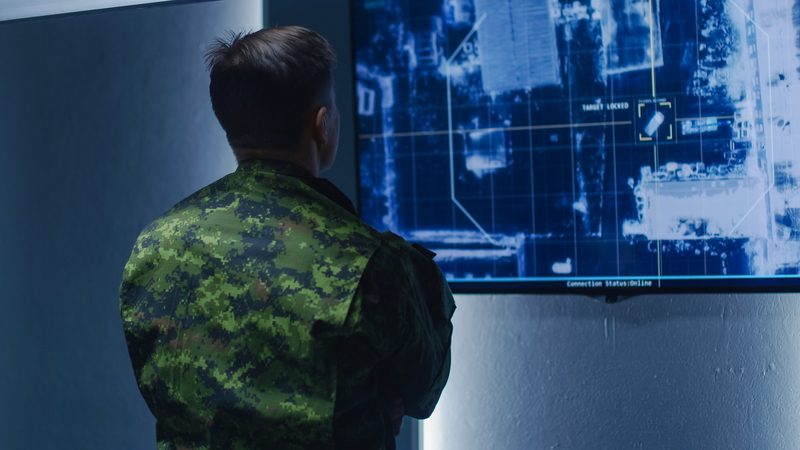 Picture: In addition to unmanned aerial vehicles, other categories of technology are also used in reconnaissance and observation, in particular space satellites and observation balloons, which have also attracted great interest in recent weeks. (illustration photo) | Shutterstock
Picture: In addition to unmanned aerial vehicles, other categories of technology are also used in reconnaissance and observation, in particular space satellites and observation balloons, which have also attracted great interest in recent weeks. (illustration photo) | Shutterstock
Several types of unmanned aerial vehicles have been and still are in operation in the Czech Army, but in all cases they are relatively small aircraft, respectively performing exclusively tactical tasks. These are, for example, the RQ-11 Raven, RQ-20 Puma or ScanEagle types, which weigh units or tens of kilograms, so they belong to the Class I UAV category. However, even before the outbreak of the war in Ukraine, there was already an intention to acquire significantly larger operational-level drones, namely Class III UAVs with a maximum weight of 1,200 kg, of which 300 kg is to be payload equipment. There was also a new requirement for the drone to be able to carry weapons or to function as an attack drone. The experience of war has clearly shown that powerful drones with long endurance, quality sensor equipment and the ability to use armaments represent extremely important tools. The war in Ukraine can be said to have further underlined what some previous conflicts had already suggested, including the war between Azerbaijan and Armenia over Nagorno-Karabakh in autumn 2020, in which Azerbaijan succeeded also thanks to the apparently highly effective deployment of a number of different types of drones.
The Turkish Bayraktar TB2 drone has become the star of this conflict and subsequently of the war in Ukraine. In addition to sensors, it can carry guided weapons and has attracted an extraordinary number of buyers thanks to its success in combat in recent years. And it is certainly not just third world countries, as NATO and EU member states are also adding to the list. Poland has ordered Bayraktar TB2s and there is talk of interest from Finland, Hungary, Slovakia and the UK, for example. It is certainly not surprising that voices calling for the acquisition of these aircraft have also been heard in the Czech Republic, but at the same time more sceptical or cautious opinions have also been expressed. There is certainly no denying that Turkish drones have scored numerous successes, but most of them have been achieved only under specific conditions. In the Nagorno-Karabakh war, for example, Armenia had only a minimal amount of suitable means of defence, whereas in Ukraine the Russian army initially made tragicomic mistakes that facilitated Bayraktar operations. In the later stages, however, it did learn its lesson and began to deploy electronic warfare systems, which greatly reduced the effectiveness of Turkish-made drones, as Russia often succeeded in disrupting their remote control.
The reasons for the huge commercial success of the Bayraktar TB2 machines also include the low cost and often the influence of Turkish diplomacy, as these are often countries that maintain very close relations with Ankara for various reasons. In addition, Baykar Makina's extensive production capacity means that it can deliver drones remarkably quickly and therefore usually scores points where there is urgent or time-pressured demand. This is true of Ukraine, of course, but to a large extent perhaps also of Poland. None of the preceding statements are meant to diminish the quality of the Bayraktar TB2 machines, they are merely statements that should put into some kind of realistic context the almost cult and iconic status of Turkish drones. Like other types of military equipment, Bayraktars simply have their advantages and disadvantages. It can be said that they represent a cheap and quickly available solution for states that demand just that. They are therefore a kind of equivalent of a mid-range car that does not excel in stunning technical finesse, but which generally fulfils what is realistically expected of it.
The Czech Army, however, has formulated somewhat more demanding requirements for its future drones, and therefore has not even approached the Turkish company Baykar Makina because its product simply does not meet these specifications. One of the reasons is, after all, the weight and payload capacity itself, as the Czech Army is asking for a much larger drone, in fact almost twice as heavy as the 700 kg Bayraktar TB2, which carries a maximum payload of 150 kg, i.e. half of what the Czech Army has formulated. Its attention has therefore turned to larger Israeli and American-made drones, which also boast extensive operational and commercial success. In the end, the choice fell on the Heron 1 type from the Israeli company IAI (Israel Aerospace Industries), which is one of the pioneers in the whole sector of unmanned aerial vehicles and has exceptional experience in this field. Already in the 1970s it created the Scout type, which then served for many years in the Israeli army and is actually one of the "archetypes" of modern drones. It was one of the first types of drone to use the most common scheme today, with a fuselage nacelle, a pusher propeller and a pair of tail spars. The IAI Scout was subsequently followed by other successful designs.
The same configuration is therefore also used by the Heron series, the first of which entered service in 1994. Subsequently, a wide range of types and versions have been developed, as IAI has continuously applied specific operational experience in the service of both the Israeli Armed Forces and foreign customers. In particular, the criticism that appeared in the Czech media after the announcement of the selection of the Heron 1 type, according to which it is allegedly an obsolete type, in fact almost thirty years old, is very misleading. The very fact that the first generation of this aircraft entered service almost thirty years ago says very little about the current level of these machines. As mentioned, the IAI company is still modernising its drones, so it is completely absurd to believe that the Czech Army should acquire a machine from the first half of the 1990s. While the basic design of the Heron 1 does indeed date from that time, it has of course undergone huge changes in construction materials over the past three decades, but especially in terms of the on-board equipment, which logically matters most. Thus, IAI Heron 1 aircraft with Czech emblems may look almost the same as drones from the 1990s, but in terms of their real capabilities they will be somewhere completely different.
It is precisely this extensive experience and repeated upgrades that have contributed to the fact that contemporary versions of Heron 1 drones rank among the world's top in terms of the quality of on-board sensors and communication systems. In fact, these dimensions are the most important things that a modern reconnaissance drone can offer its operator. Cameras for day and night conditions, radars for tracking ground targets or sensors for electronic reconnaissance acquire data that must then be delivered to commanders, which of course requires high-quality communication channels that can transmit large volumes of data quickly and securely. The commander can therefore have a wide range of information about the situation on the battlefield in real time, know the exact position of his own and his opponent's units and, on that basis, immediately make decisions and issue orders, the results of which he can then monitor again in real time. It is the fact that large unmanned machines like Heron 1 can operate over the battlefield for very long periods of time and provide perfect situational awareness that leads to a fundamental transformation of the entire command decision-making process.
After all, this change was convincingly demonstrated by the war in Ukraine, as the Ukrainians, although they do not yet have drones comparable to the Heron series, have been able to deploy less advanced and less powerful machines very effectively. This has given them a huge information advantage over Russia, whose military should theoretically have a wide arsenal of modern drones, but practice shows that Russian machines dramatically lag behind the contemporary world leaders in terms of quality and quantity. More importantly, however, the command process in the Ukrainian military has already undergone that fundamental systemic transformation and is therefore already benefiting from the permanent situational awareness that drones provide over the battlefield. In contrast, the Russian army has clearly not undergone this change, but this is not really surprising, as the necessary conditions for the application of this change include great flexibility and support for the initiative of commanders, something that the Russian army lacks. In other words, the Russian military culture is not compatible with the capabilities that current reconnaissance drones can offer.
The first army in the world to undergo this transformation was the army of the State of Israel, where, on the contrary, there has long been a culture that supports precisely such changes and innovations. Thus, the Israelis have long used a diverse range of drones that give commanders a perfect picture of the situation on the battlefield and dramatically increase the speed and efficiency of the command process. Some of these drones can also carry weapons, but the Israeli experience correlates with what has also been demonstrated by the deployment of Turkish drones over Nagorno-Karabakh and Ukraine. The ability of a drone to carry and launch guided weapons is certainly potentially very useful, especially when it is necessary to hit a target that could soon move or otherwise become inaccessible (the term "time-critical target" is used), but such situations are much rarer in practice than one might think. Therefore, the use of weapons is only a secondary activity, while the most important activity is the permanent monitoring of the battlefield. It is therefore not surprising that the Czech Army decided to acquire drones from Israel, which has the most experience in this field. A similar path is also followed by France, whose Harfang drone is based on the Heron type.
In addition to battlefield surveillance and occasional weapon launching, however, powerful drones can perform many other activities, not only in the military sphere. Some countries that have acquired Israeli drones also use them in the civilian sphere, as the machines' high-tech sensors can be applied in a variety of ways. Common activities include monitoring the situation during natural and other disasters, as the current situation in Turkey and Syria following the devastating earthquake there illustrates. Modern drones are therefore also capable of assisting in search and rescue operations, helping to extinguish fires, guarding borders or monitoring various illegal activities. They therefore also have huge potential in the homeland security sector. Of course, the payload need not be limited to sensors, as drones can also carry, for example, relay equipment to extend the effective range of communication systems. In this sense, it can be concluded that high-performance drones operating at high altitudes offer capabilities that make them a kind of alternative or complement to space satellites. The term 'pseudo-satellites' is even sometimes used for high altitude drones.
However, the latter term has a broader meaning, as other flying vehicles capable of partially replacing or complementing satellites in space orbit are also considered as 'pseudo-satellites'. In the first place, these are lighter-than-air vehicles, i.e. airships and balloons, which are certainly worth mentioning, not least because of a series of incidents in early 2023 when Chinese spy balloons appeared over the US. Despite the widespread public surprise, however, this was no big news, as reconnaissance, warning, communication, weather and other balloons have been found and used in the militaries of many countries for a long time, but as a rule they have only attracted the interest of experts and hobbyists. Among the operators of military balloons will soon be the Czech Army, which for several years has been implementing the STRATOM (Stratospheric Imaging System) programme, the main goal of which is to launch a special balloon to an altitude of about 25 000 m, which will stay there for months and carry optical, radar and other sensors to monitor the surface. This will not be espionage, as STRATOM will only monitor the territory of the Czech Republic, although of course its deployment in foreign missions of the Czech Army cannot be ruled out.
An even more ambitious plan is represented by GOLEM (Global Orbital Electro-Optical System), because in this case it is a real space satellite, or a system of satellites in low orbit. The satellites will carry cameras capable of imaging the Earth's surface, so the Czech army will no longer be fully dependent on image data from allies or commercial companies in this respect, as it will have its own space exploration capabilities. There is certainly no need to write in detail about the importance of satellite data, and it is enough to mention media reports about how crucial this data is for the Ukrainians, who are provided with it by the US and other NATO countries. In addition to this, there is also the logical possibility that the Czech Republic could lease these capacities to other countries, and, as in the case of the STRATOM balloon, the possibility of supplying such systems, so to speak, on a turnkey basis to foreign customers can also be considered prospectively. The combination of Heron 1 drones, STRATOM stratospheric balloons and GOLEM space satellites will thus create a kind of three-layer sensor system that will be exclusively under the control of the Czech Army and can dramatically increase the efficiency of its command decision-making processes.
Cooperation with Israel is also proposed in this respect, as it is a typical example of a small state that has decided not to be fully dependent on foreign space capabilities and has developed its own satellites. The first Israeli reconnaissance satellite, Ofeq, was launched in 1988 and since then many more have been added, which, in addition to high-resolution cameras for optical reconnaissance, also carry synthetic aperture radars that enable, among other things, high-quality terrain mapping. The main supplier of the Ofeq series satellites is the aforementioned IAI, which has taken this experience and technology to the commercial market by supplying satellites based on the Ofeq series to foreign customers. Its offer includes several satellites of the OptSat, TecSAR and OptSAR series, which carry optical (a)or radar sensors and can be applied in both military and civilian spheres. Although the Czech GOLEM project is so far being implemented only by Czech entities, IAI could become an ideal partner to supply modern space technology, while the Israeli Armed Forces can share its extensive experience in building and operating such a system.
Finally, returning once again to the war in Ukraine, this conflict clearly demonstrates the enormous importance of information superiority. The Ukrainian army does not usually have the extensive resources of the Russian army, but thanks to the massive support of Western countries it can deploy more modern and effective systems, and not only weapons. It is extremely important that NATO countries also support Ukraine with intelligence, such as information from satellites and other reconnaissance assets, which then allows Ukraine to plan and execute military operations much more effectively. In addition, the Ukrainians are far more effective in deploying their drones compared to the Russians, thanks to which Ukrainian commanders enjoy significantly better situational awareness. All of this creates that huge information advantage, which is at least as important as the destructive power of the weapons themselves, because information superiority allows the Ukrainians to strike faster, more accurately and more effectively than the Russians. Therefore, building its own reconnaissance system, including unmanned aircraft and other platforms, should also be among the priorities of the Czech Army, because all indications are that it is a crucial tool in modern conflicts.












